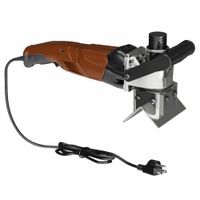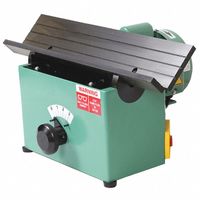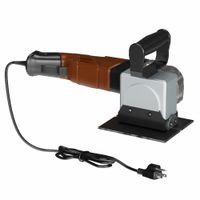Call +(254) 703 030 000 / 751 483 999 / 721 704 777
- Home
- Tools
- Power Tools
- Grinders Cut Off Tools
- Beveling Machines Weld Shavers
.....Read More
Frequently Asked Questions
What is the difference between a beveling machine and a weld shaver?
A beveling machine and a weld shaver are both tools used in metalworking, but they serve different purposes and operate differently.
A beveling machine is designed to create a beveled edge on a workpiece, typically metal. This process involves cutting the edge of the material at an angle to prepare it for welding or to meet specific design requirements. Beveling is crucial for ensuring strong welds, as it allows for better penetration and fusion of the welding material. Beveling machines can be manual or automated and are used in various industries, including construction, shipbuilding, and pipeline manufacturing. They can handle different materials and thicknesses, and the angle of the bevel can be adjusted according to the needs of the project.
On the other hand, a weld shaver is used to remove excess weld material, or weld beads, from the surface of a workpiece after welding. This process is essential for achieving a smooth, even surface, which is often required for aesthetic reasons or to meet specific engineering standards. Weld shavers are typically handheld tools that use rotating blades or abrasive surfaces to shave down the weld bead without damaging the surrounding material. They are commonly used in industries where the appearance of the weld is important, such as automotive and aerospace manufacturing.
In summary, the primary difference lies in their functions: beveling machines prepare the edges of materials for welding by creating an angled surface, while weld shavers are used post-welding to smooth out and refine the welds.
How do beveling machines improve welding preparation?
Beveling machines enhance welding preparation by creating precise and consistent angles on the edges of metal workpieces, which is crucial for achieving strong and reliable welds. These machines automate the beveling process, ensuring uniformity and accuracy that is difficult to achieve manually. By producing clean and smooth edges, beveling machines reduce the risk of defects such as incomplete fusion or porosity in the weld.
The beveling process also increases the surface area of the metal edges, allowing for better penetration of the welding material. This results in stronger weld joints, which are essential for structural integrity, especially in critical applications like pipelines, pressure vessels, and structural steelwork.
Additionally, beveling machines improve efficiency by significantly reducing the time and labor required for edge preparation. They can handle various materials and thicknesses, offering versatility for different welding projects. The machines also enhance safety by minimizing the need for manual grinding, which can produce harmful dust and debris.
Overall, beveling machines streamline the welding preparation process, improve the quality and strength of welds, and enhance workplace safety and productivity.
What are the advantages of using a beveling machine over an angle grinder?
A beveling machine offers several advantages over an angle grinder:
1. **Precision and Consistency**: Beveling machines provide precise and consistent bevel angles, which are crucial for high-quality welds and fit-ups. Angle grinders rely on manual skill, leading to potential inconsistencies.
2. **Speed and Efficiency**: Beveling machines are designed for rapid material removal and can process edges much faster than angle grinders, increasing productivity, especially in large-scale operations.
3. **Safety**: Beveling machines are generally safer to operate as they are designed to minimize operator fatigue and reduce the risk of accidents. Angle grinders can be hazardous due to the potential for kickback and the need for manual handling.
4. **Surface Finish**: Beveling machines produce a cleaner and smoother finish, reducing the need for additional surface preparation. Angle grinders can leave rough edges that may require further work.
5. **Reduced Operator Fatigue**: Beveling machines are often automated or semi-automated, reducing the physical strain on operators. Angle grinders require continuous manual effort, leading to fatigue over time.
6. **Versatility**: Many beveling machines can handle a variety of materials and thicknesses with adjustable settings, whereas angle grinders may require different discs and more manual adjustments.
7. **Dust and Debris Management**: Beveling machines often come with integrated dust collection systems, improving the work environment and reducing cleanup time. Angle grinders can create significant dust and debris.
8. **Long-term Cost Efficiency**: Although the initial investment in a beveling machine may be higher, the increased efficiency, reduced labor costs, and lower risk of errors can lead to cost savings over time compared to using angle grinders.
How do handheld bevelers differ from stationary beveling machines?
Handheld bevelers and stationary beveling machines differ primarily in terms of mobility, size, application, and operational flexibility.
1. **Mobility and Portability**: Handheld bevelers are portable and designed for on-site use, allowing operators to move freely and work on large or immobile objects. In contrast, stationary beveling machines are fixed in one location, requiring materials to be brought to the machine.
2. **Size and Capacity**: Handheld bevelers are generally smaller and suitable for lighter, less intensive tasks. They are ideal for smaller projects or when working in confined spaces. Stationary machines are larger, more robust, and capable of handling heavy-duty tasks, making them suitable for industrial applications and large-scale production.
3. **Precision and Consistency**: Stationary beveling machines offer higher precision and consistency due to their stable setup and advanced features, such as automated controls and adjustable settings. Handheld bevelers rely more on the operator's skill, which can lead to variations in the bevel quality.
4. **Speed and Efficiency**: Stationary machines typically operate faster and more efficiently, processing larger volumes of material in less time. Handheld bevelers are slower, as they depend on manual operation and are better suited for smaller, less time-sensitive tasks.
5. **Versatility and Application**: Handheld bevelers are versatile, capable of working on various materials and angles, and are often used for maintenance, repair, and small-scale fabrication. Stationary machines are specialized for specific tasks, such as pipe beveling or edge finishing, and are used in manufacturing environments where high throughput is required.
6. **Cost and Investment**: Handheld bevelers are generally less expensive, with lower initial investment and maintenance costs. Stationary machines require a higher investment but offer greater long-term productivity and efficiency for large-scale operations.
What safety precautions should be taken when using beveling machines?
1. **Personal Protective Equipment (PPE):** Wear safety goggles, gloves, ear protection, and steel-toed boots to protect against flying debris, noise, and heavy equipment.
2. **Training and Certification:** Ensure operators are properly trained and certified to use the beveling machine, understanding its functions and safety features.
3. **Machine Inspection:** Regularly inspect the machine for any signs of wear, damage, or malfunction. Ensure all guards and safety devices are in place and operational.
4. **Work Area Safety:** Keep the work area clean and free of obstructions. Ensure adequate lighting and ventilation to prevent accidents and exposure to harmful fumes.
5. **Secure Workpiece:** Properly secure the workpiece to prevent movement during operation, which could lead to inaccurate beveling or accidents.
6. **Correct Setup:** Use the correct settings and tools for the material being beveled. Incorrect settings can lead to machine damage or operator injury.
7. **Emergency Procedures:** Familiarize yourself with emergency stop procedures and ensure they are easily accessible.
8. **Avoid Loose Clothing:** Do not wear loose clothing or jewelry that could get caught in the machine.
9. **Stay Focused:** Maintain full attention on the task to prevent accidents caused by distractions.
10. **Proper Maintenance:** Follow the manufacturer’s maintenance schedule to ensure the machine operates safely and efficiently.
11. **Power Supply Safety:** Ensure the machine is properly grounded and connected to the correct power supply to prevent electrical hazards.
12. **Safe Handling of Blades:** Handle cutting blades with care, ensuring they are sharp and properly installed to prevent accidents and ensure clean cuts.
13. **Post-Operation Checks:** After use, turn off the machine, clean the area, and check for any issues that need addressing before the next use.
How do you choose the right beveling machine for a specific project?
To choose the right beveling machine for a specific project, consider the following factors:
1. **Material Type**: Identify the material you will be working with, such as steel, aluminum, or plastic, as different machines are optimized for different materials.
2. **Material Thickness**: Ensure the machine can handle the thickness of the material. Some machines are designed for thin sheets, while others can handle thicker plates.
3. **Bevel Angle**: Determine the required bevel angle for your project. Some machines offer adjustable angles, while others are fixed.
4. **Bevel Width**: Consider the width of the bevel needed. Machines vary in their ability to create wide or narrow bevels.
5. **Production Volume**: Assess the scale of your project. For high-volume production, choose a machine with a higher speed and efficiency.
6. **Portability**: Decide if you need a portable machine for on-site work or a stationary one for a workshop setting.
7. **Power Source**: Choose between electric, pneumatic, or battery-powered machines based on availability and convenience.
8. **Precision and Finish**: Evaluate the precision and quality of the finish required. Some machines offer smoother finishes and higher accuracy.
9. **Ease of Use**: Consider the machine's user-friendliness, including setup, operation, and maintenance.
10. **Budget**: Balance your needs with your budget. Higher-end machines offer more features but at a higher cost.
11. **Brand and Support**: Research reputable brands and consider the availability of customer support and spare parts.
12. **Safety Features**: Ensure the machine has adequate safety features to protect operators.
By evaluating these factors, you can select a beveling machine that meets the specific requirements of your project efficiently and effectively.
What maintenance is required for beveling machines and weld shavers?
Maintenance for beveling machines and weld shavers involves several key tasks to ensure optimal performance and longevity:
1. **Regular Cleaning**: Remove metal shavings, dust, and debris from the machine after each use to prevent buildup that can affect performance. Use compressed air or a soft brush for thorough cleaning.
2. **Lubrication**: Apply appropriate lubricants to moving parts, such as bearings and gears, to reduce friction and wear. Follow the manufacturer's recommendations for the type and frequency of lubrication.
3. **Inspection of Cutting Tools**: Regularly inspect cutting blades and tools for wear and damage. Replace or sharpen them as needed to maintain cutting efficiency and precision.
4. **Alignment Checks**: Ensure that all components are properly aligned to prevent uneven bevels or shaves. Misalignment can lead to poor-quality work and increased wear on the machine.
5. **Tightening of Fasteners**: Check and tighten all bolts, screws, and fasteners to prevent loosening due to vibration during operation.
6. **Electrical System Maintenance**: Inspect electrical components, such as switches and wiring, for signs of wear or damage. Replace faulty parts to prevent electrical failures.
7. **Coolant System Maintenance**: If the machine uses a coolant system, check for leaks and ensure the coolant is clean and at the correct level. Replace or replenish as necessary.
8. **Safety Features Check**: Regularly test safety features, such as emergency stops and guards, to ensure they are functioning correctly.
9. **Calibration**: Periodically calibrate the machine to ensure accuracy in beveling and shaving operations.
10. **Documentation and Record Keeping**: Maintain a log of all maintenance activities, including dates and details of inspections, repairs, and part replacements, to track the machine's condition over time.
By adhering to these maintenance practices, beveling machines and weld shavers can operate efficiently and safely, reducing downtime and extending their service life.




